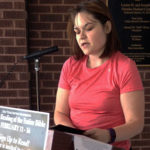- The Explore the Bible lesson for May 5 focuses on Mark 11:15-19; 12:41-44.
For those acquainted with the Gospels and the portrait of Jesus that the writers paint, we might typically call to our imagination an image of Jesus surrounded by children or extending a tender, healing touch to a crippled woman or even beckoning Peter to come out on the water. While certainly powerful, the Jesus of those images appears meek and mild, loving and gracious.
The image of Jesus portrayed in the Mark 11 stands in stark contrast, though. There was nothing meek and mild about Jesus as he stormed into the temple complex and flipped the tables of the moneychangers and released the doves from their cages. The prophet from Galilee had come to Jerusalem to the temple in the spirit and in the Spirit of the prophets of old.
If the image of the aggressive and indignant Jesus were not astounding enough, even more startling was that this episode took place in and was directed against the temple, the temple devoted to the Lord, the God of Israel. On this Monday of the so-called Passion Week, Jesus had come to pick a fight, and he would see it through to the end. An appropriate assessment of these events are the legendary words of Julius Caesar as he crossed the Rubicon, “The die is cast.”
Cleansed (Mark 11:15-17)
To convey the significance of Jesus’ actions in the temple, Mark framed the story using the literary technique we have seen many times already: the Markan sandwich (or intercalation). A particularly peculiar story about Jesus and fig tree immediately precedes Mark’s account of the temple cleansing (11:12-14). Jesus approached a fig tree looking for fruit. Finding it had none, he cursed it. According to Mark, on the following day the disciples, who had heard Jesus’ pronouncement on the tree, declared their amazement upon seeing the tree withered from the roots (11:20-21). Taken on its own, the story makes little sense (Was Jesus really that irritated with a tree?). As another example of the Markan sandwich, though, the interrelated stories convey a powerful message. The Lord had come to the temple to look for fruit. Would he find it?
The moneychangers provided the opportunity to exchange the Roman currency of the day for the Tyrian coinage required for the temple tax, and the selling of sacrificial animals for pilgrims was an established practice. The site for these activities, however, had been the Mount of Olives. On that particular day, what Jesus witnessed was, according to William Lane, that the Sadducees had “transform[ed] the Court of Gentiles into an oriental bazaar and a cattle mart” (Gospel of Mark, 406). One need only read Solomon’s dedication of the first temple (1 Kings 8:41-43) to find the basis of Jesus’ fury over the treatment of the gentiles. Jesus reminded them of Isaiah’s prophecy that the temple was to be for “all nations” (11:17).
Perhaps even more egregious than his violent disruption of commerce, though, was Jesus’ invocation of one of the most inflammatory sermons of all the prophets: Jeremiah’s infamous temple sermon (Jeremiah 7). In the context of the sermon from which Jesus borrowed the phrase “den of robbers,” Jeremiah challenged his hearers that the temple would not save them nor would the temple necessarily be saved. In light of the fig tree episode and Jesus’ impending teachings about the temple (see Mark 13:1ff), it would seem Jesus invited the whole thrust of Jeremiah’s sermon to bear on the temple before him. The fruit of repentance would be the only thing to save this temple from the fate of the fig tree.
The Lord remains unimpressed by empty religious expressions, even those he has sanctioned. Not everything we do on a Sunday morning or a Wednesday night in a church building has automatic approval. The fruit produced is what matters. So, what fruit are you seeing?
Feared (Mark 11:18-19)
The leaders of the religious establishment associated with the temple were not in the repenting mood. If this prophet from Galilee wanted a fight, he would have one. Unfortunately in their eyes, however, this prophet was eroding their base of power. The people were being moved by his provocative teaching. They had too much to lose if this trend continued.
The religious leaders of the temple appear awfully foolish from our vantage point. Alas, we are cut from the same mold as they, though. Might it be that the Lord is wanting to or is even doing something amazing, but you feel not amazement but fear? Are you on the right side?
Sign up for our weekly edition and get all our headlines in your inbox on Thursdays
Observed (Mark 12:41-42)
The events of this scene came on the tail end of string of controversies between Jesus and the various agents of Jewish power in Jerusalem (Mark 11:27-12:40). Power was once again on display here at the receptacles for the temple offerings; this time it was money. The deposits of the temple’s wealthy patrons would have made an impression to both eyes and ears. In contrast, the widow’s gift was not only the least valuable coin in circulation but also the lightest (Craig Keener, IVP Bible Background Commentary: New Testament, 157). It would have gone unnoticed—at least by most everyone.
This story was included to highlight the contrast between the two sums given, but we should not overlook the fact that a steady stream of unidentified people also made deposits (11:41). Be reminded of Jesus’ teaching in the Sermon on the Mount about “acts of righteousness” performed for people to see (Matthew 6:1-18). We can be just as braggadocios about our great sacrifice as we can about our great generosity.
Commended (Mark 12:43-44)
This teachable moment was too significant to miss. Jesus called the attention of the disciples to the contrast of the two offerings. It was the widow’s offering that stood out, but not just because it was commendable. It was also lamentable.
Jesus affirmed the woman’s devotion to the Lord that would compel her to give her everything, literally “her whole life.” Though Jesus did not explicitly commend her faithfulness, this is a reasonable inference to draw from the story.
The lamentable side of her offering emerges from the context, though. Beginning in 11:12, Mark has included story after story and teaching after teaching that has demonstrated Jesus’ rebuke of the religious institutions of Jerusalem. That rebuke would find its most tangible expression in Jesus’ words to his disciples about the temple (13:2). Though the widow devoted her life’s savings to God, the stewards of that money were the corrupt and misguided religious leaders. This scene portrays in painful detail how the innocent and devoted were the real victims of the temple’s corruption.
Any of us who utilize the resources of the church or receive money from other believers in the form of a paycheck or otherwise should not fail to feel the weight of the reality that those resources come from resources people have given to the Lord. Are we honoring the widow’s mite?
Jeremy Greer is assistant professor of religion at East Texas Baptist University in Marshall.














We seek to connect God’s story and God’s people around the world. To learn more about God’s story, click here.
Send comments and feedback to Eric Black, our editor. For comments to be published, please specify “letter to the editor.” Maximum length for publication is 300 words.